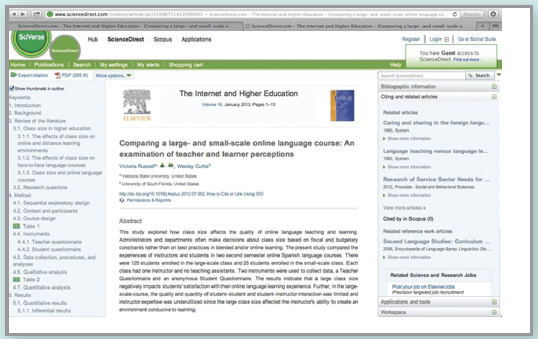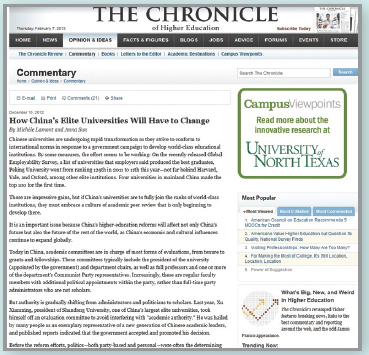Electronic Sources
45. Article with a DOI A DOI (digital object identifier) is a unique number assigned to specific content, such as a journal article. If a DOI is available, include it; you do not need to provide a database name or URL.
Hughes, V. (2012). Stress: The roots of resilience. Nature, 490(7419), 165-167. doi:10.1038/490165a
46. Article without a DOI If no DOI is available, give the URL for the journal’s home page.
Varvil-Weld, L., Turrisi, R., Scaglione, N., Mallett, K. A., & Ray, A. E. (2013). Parents’ and students’ reports of parenting: Which are more reliably associated with college student drinking? Addictive Behaviors, 38 (3), 1699-1703. Retrieved from http://www.journals.elsevier.com
47. Online periodical article An article published online is unlikely to have page numbers. Include the URL for the site from which the article was retrieved.
Barnes, W. B., & Slate, J. R. (2013). College readiness is not one-size-fits-all. Current Issues in Education. Retrieved from http://cie.asu.edu/ojs/index.php/cieatasu/article/view/1070
How do I cite online articles using APA style?
Tutorial
How do I cite online articles using APA style?

Many periodical articles can be accessed online, either through a journal or magazine’s Web site or through a database. (See also Chapter 12.)

The author. Give the last name first, followed by a comma and initials. Separate the names of multiple authors with commas; use an ampersand (&) before the final author’s name.
The date of publication. Put the year in parentheses and end with a period (outside the closing parenthesis). For magazines and newspapers, include the month and, if relevant, the day (2012, April 13).
The article title. Give the full title; include the subtitle (if any), preceded by a colon. Do not underline, italicize, or put the title or subtitle in quotes. Capitalize only the first word of the title, the first word of the subtitle, and any proper nouns or proper adjectives. End with a period.
The periodical title. Italicize the periodical title, and capitalize all major words. Insert a comma.
The volume number and issue number. For magazines and journals, include the volume number, italicized. For magazines and for journals that start each issue with page 1, include the issue number in parentheses, not italicized. Insert a comma.
Inclusive page number(s). Give all of the numbers in full (317-327, not 317-27). For newspapers, include the abbreviation “p.” or “pp.” for page numbers and, if relevant, section letters (p. B12).
The DOI or URL. Give the unique digital object identifier (DOI), if available; you do not need to provide a retrieval date, database name, or URL. If there is no DOI, include the words “Retrieved from” and the URL of the journal or magazine home page.
48. Web document For a stand-alone Web source such as a report, or a section within a larger Web site, cite as much of the following information as possible: author, publication date, document title, and URL. If the content is likely to be changed or updated, include your retrieval date.
Scirica, C. (2012, September 14). Could banning large soft drinks be effective in the fight against obesity? Retrieved from http://www.massgeneral.org/about/newsarticle.aspx?id=3743
United States Mint. (2012). How coins are made. Retrieved from http://www.usmint.gov/faqs/circulating_coins/index.cfm?action=coins
How do I cite works from Web sites using APA style?
Tutorial
How do I cite works from Web sites using APA style?

You will likely need to search the Web site to find some of the citation information you need. For some sites, all of the details may not be available; find as many as you can. Remember that the citation you provide should allow readers to retrace your steps electronically to locate the sources..

The author of the work. Give the last name first, followed by a comma and initials. Separate the names of multiple authors with commas; use an ampersand (&) before the final author’s name. If the source has no author, list the title first and follow it with the date.
The date of publication. Put the year in parentheses and include the month and day, if available. If there is no date, use “n.d.” in parentheses. End with a period (outside the closing parenthesis).
The title of the work. Give the full title, italicized; include the subtitle (if any), preceded by a colon. Capitalize only the first word of the title, the first word of the subtitle, and any proper nouns or proper adjectives.
Retrieval information. Include a retrieval date if the material is likely to be changed or updated, or if it lacks a set publication date. (Because this commentary has a set publication date, the retrieval date is not necessary.) End with the URL.
49. Online book Cite the electronic version only if a print version is not available or is hard to find.
Robinson, K. (n.d.). Beyond the wilderness. Retrieved from http://onlineoriginals.com/showitem.asp?itemID=113
50. E-mail message or real-time communication Because e-mail messages and real-time communication, such as text messages, are difficult or impossible for your readers to retrieve, APA does not recommend including them in your references list. You should treat them as personal communication and cite them parenthetically in your text (see item 13).
51. Message posted to a newsgroup, electronic mailing list, or online discussion forum List the author, posting date, and the title of the post or message subject line. Include a description of the message or post in square brackets. End with the URL where the archived message can be retrieved. Include the name of the group, list, or forum if it’s not part of the URL.
Skambis, K. (2011, October 27). Re: Welcome to the lung connection: Living with lung disease [Online discussion list comment]. Retrieved from http://connection.lungusa.org/discussions/welcome-to-the-lung-connection-living-with-lung-di/2011/07/25/1-welcome-to-the-lung-connection-living-with-lung
52. Article or page on a wiki Because the material on a wiki is likely to change, include a retrieval date.
Diabetes. (n.d.). WikiHealth. Retrieved March 22, 2013, from http://www.wikihealth.com/Diabetes
53. Blog To cite an entry on a blog, give the author (or screen name, if available), the date the material was posted, and the title of the entry. Include the description “Web log post” in square brackets and the URL. To cite a comment on a blog, use the description “Web log comment.”
Rubin, G. (2012, October 17). Does waiting in a line drive you crazy? Here’s why [Web log post]. Retrieved from http://www.happiness-project.com/happiness_project/2012/10/does-waiting-in-a-line-drive-you-crazy-heres-why/
54. Podcast Give the name of the producer, the date of the podcast, and the title. Include a description in square brackets and the URL.
Goldsmith, J. (Producer). (2012, December 23). Joss Whedon — The Avengers Q&A [Audio podcast]. Retrieved from http://www.theqandapodcast.com/2012/12/joss-whedon-avengers-q.html
55. Online video post Give the name of the creator, the date it was posted, and the title. Include a description in square brackets and the URL.
Neistat, C. (2012, November 3). Staten Island hurricane destruction [Video file]. Retrieved from https://www.youtube.com/watch?feature=player_embedded&v=Wr9594oKZNQ#
56. Computer software or game Sometimes a person is named as having rights to the software or game: in that case, list that person as the author. Otherwise, begin the entry with the name of the program or game, and identify the source in square brackets after the name as “Computer software” or “Computer game.” Treat the organization that produces the software or game as the publisher. If you’re referring to a specific version that isn’t included in the name, put this information last.
Rosetta Stone Spanish (Latin America) Level 1 [Computer software]. Arlington, VA: Rosetta Stone.